CODEOFBELL X-CASE Review
CODEOFBELL’s X-CASE carries comfortably in all three carrying modes and is loaded with features, though some are done better than others.
Our Verdict
Save time. Get access to brief summaries of our reviews so you can browse and make decisions more efficiently.
Pros
- Comfortable harness system in each mode
- Can be expanded further via ANNEX-series gear
- Tons of pockets with varied sizes and styles for organization
Cons
- Hip belt not as secure as we’d like
- Tough to access pockets when main compartment is full
- Only opens one way despite multiple carry modes
Technical Details
-
Capacity
20l
folded | 42L - expanded
-
Weight (lb)
4.95 lb (2.2 kg)
-
Dimensions
17 in x 12.5 in x 6 in (43.2 x 31.8 x 15.2 cm)
folded | 17 in x 12.5 in x 12 in - expanded
-
Notable Materials
YKK Zippers, Woojin Hardware, X-Pac
-
Laptop Compartment Size
15"
-
Warranty Information
Full Review
Get up to 10% off CODEOFBELL • Join Pack Hacker Pro
CODEOFBELL is a brand we’ve come to know for their gear that’s absolutely packed to the gills with features. A good example of this is the ANNEX 360, a relatively small sling weighing around six ounces. Despite its diminutive size, it has plenty of surprises in the way it can be carried, its compartment setup, and the number of attachment points it has. Now imagine if CODEOFBELL scaled that up to, say, a 20-liter brief. No need to put your head in the clouds, though, because that’s the subject of this review: the X-CASE.
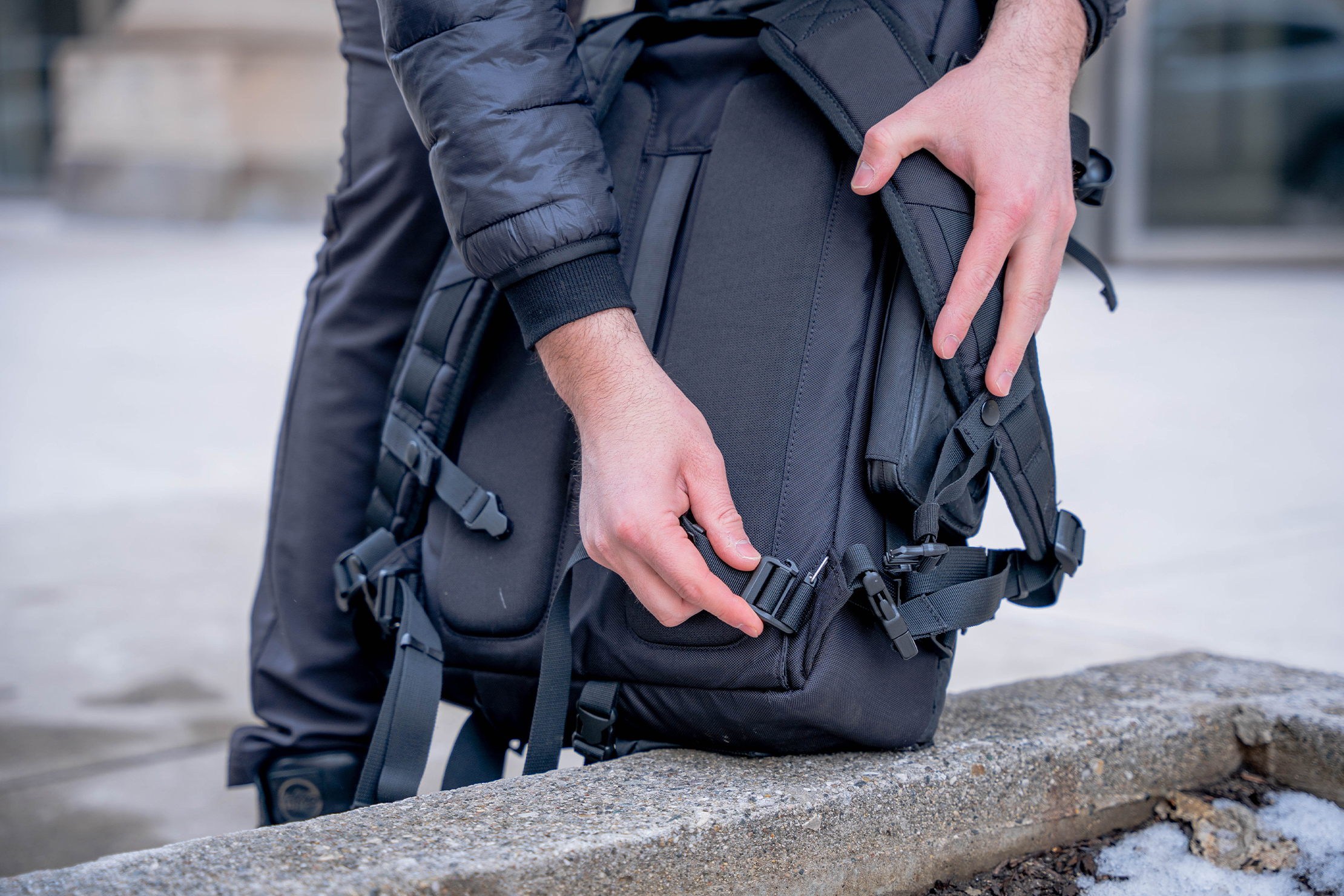
Pronounced “cross-case,” this briefcase/messenger bag/backpack definitely has a lot going on inside and outside. It has Hypalon loops, magnetic Fidlock buckles, an expandable front compartment, and more pockets than we can occupy. If that’s not enough, the X-CASE can even be supplemented by externally mounting ANNEX-series gear to it. The X-CASE even manages to nail the basics of being comfortable to carry, whether it’s in backpack, briefcase, or messenger bag mode. It’s not perfect, though, as this busy-looking bag shows us it has a few rough edges, some major, some minor. Read on to find out what those are, but buckle up, as this will be a lengthy one.
Materials & Aesthetic
The X-CASE is absolutely bristling with aesthetic features, whichever way you slice it. There is always something to point at and wonder about this bag. The numerous straps, the X-Pac fabric, the boxy shape—all of these play a part in the way the X-CASE looks. Is it a good look, though? That’s a very subjective question; thus, we’re going to give you our subjective answer: yes, yes it does, but with some reservations.
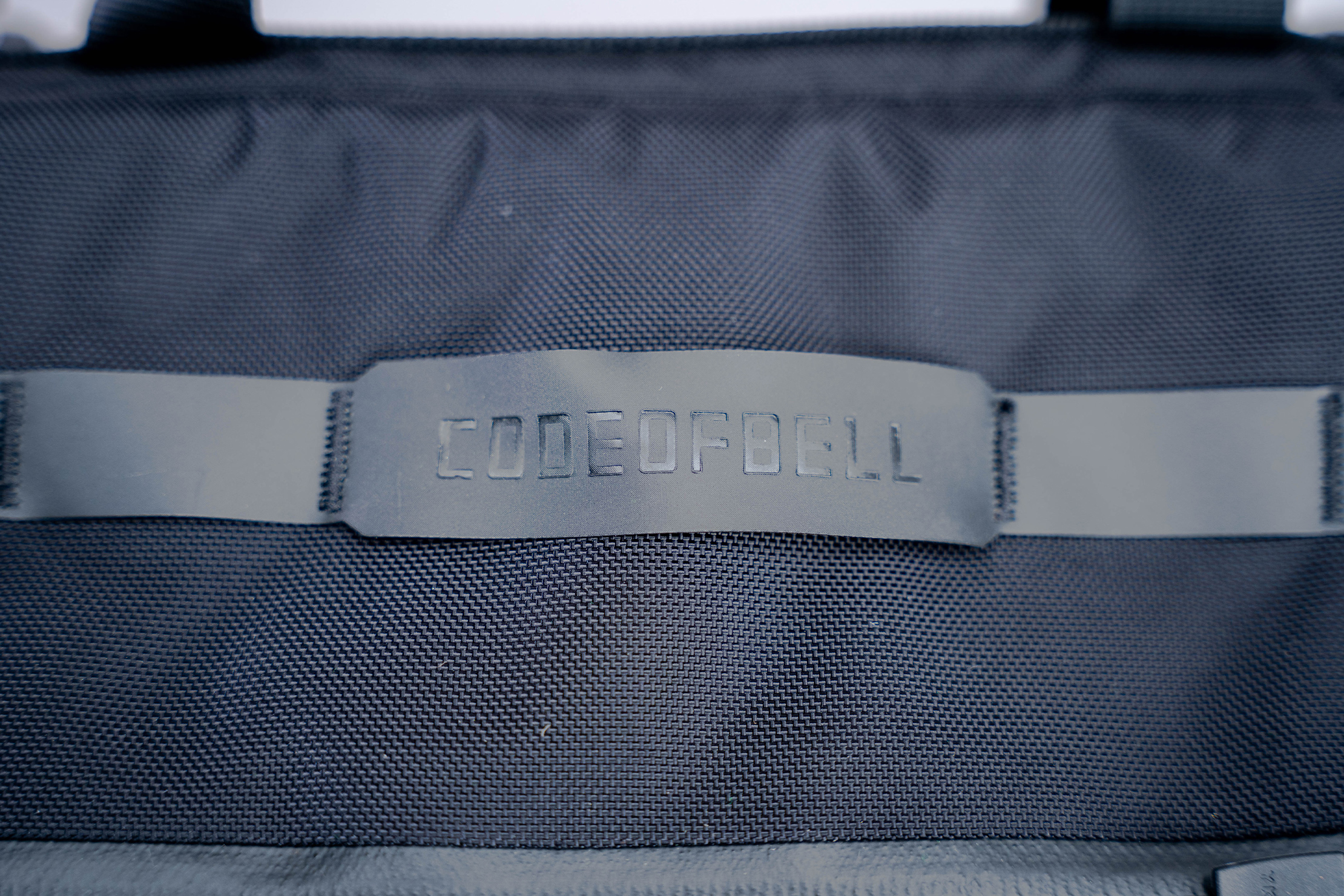
Long-time readers will know that we’re not huge fans of excessive straps. Don’t worry, we haven’t changed our view on that. The strappy X-CASE looks a bit messy, and it can also feel messy at times. Again, this is highly subjective, so if you’re a fan of the strappy look, then the X-CASE has that in spades. You’re not alone, either; some of our Pack Hacker Pro members love the look.
In case you’re wondering, the X-CASE only comes in this one colorway: Pitch Black. It’s the way of the brand, and it’s arguably the safest choice since black is easy to pair with other colors. This is the point where we’d usually say that black’s discreet look offers an advantage when it comes to security. However, we think the X-CASE’s unique looks can turn a lot of heads and overcome the stealthy colorway; let’s just hope none of them have grubby hands.

The X-CASE’s front dons the easily-recognizable pattern of X-Pac, a highly water-resistant and durable fabric. So, what exactly is X-Pac? Simply put, it’s a material made of multiple layers, starting with a nylon face, a thin polyester film, polyester X-PLY mesh, then polyester taffeta backing. Combined, these materials give the fabric its signature waterproof characteristic. To note, this doesn’t make the X-CASE a waterproof bag, as water can still seep through its other components. Also, despite the similarity in naming, it’s not a material exclusive to CODEOFBELL’s gear. We’ve seen the fabric in a lot of bags over the years, like Able Carry’s Max Backpack, and some of Aer’s that come in X-Pac variants. The former even made the Able Cooler, a very resilient lunchbox courtesy of X-Pac’s properties.
The rest of the X-Case that’s not covered in X-Pac is made of ballistic nylon. Though we’re unsure of the denier, the fabric feels sturdy enough to resist mild abrasion (i.e., setting the bag on rough pavement). More so than the X-Pac and ballistic nylon, the X-CASE’s underlying structure gives the bag a reassuring amount of rigidity. That, of course, excludes the baggy expandable front compartment, which we’ll discuss later on.
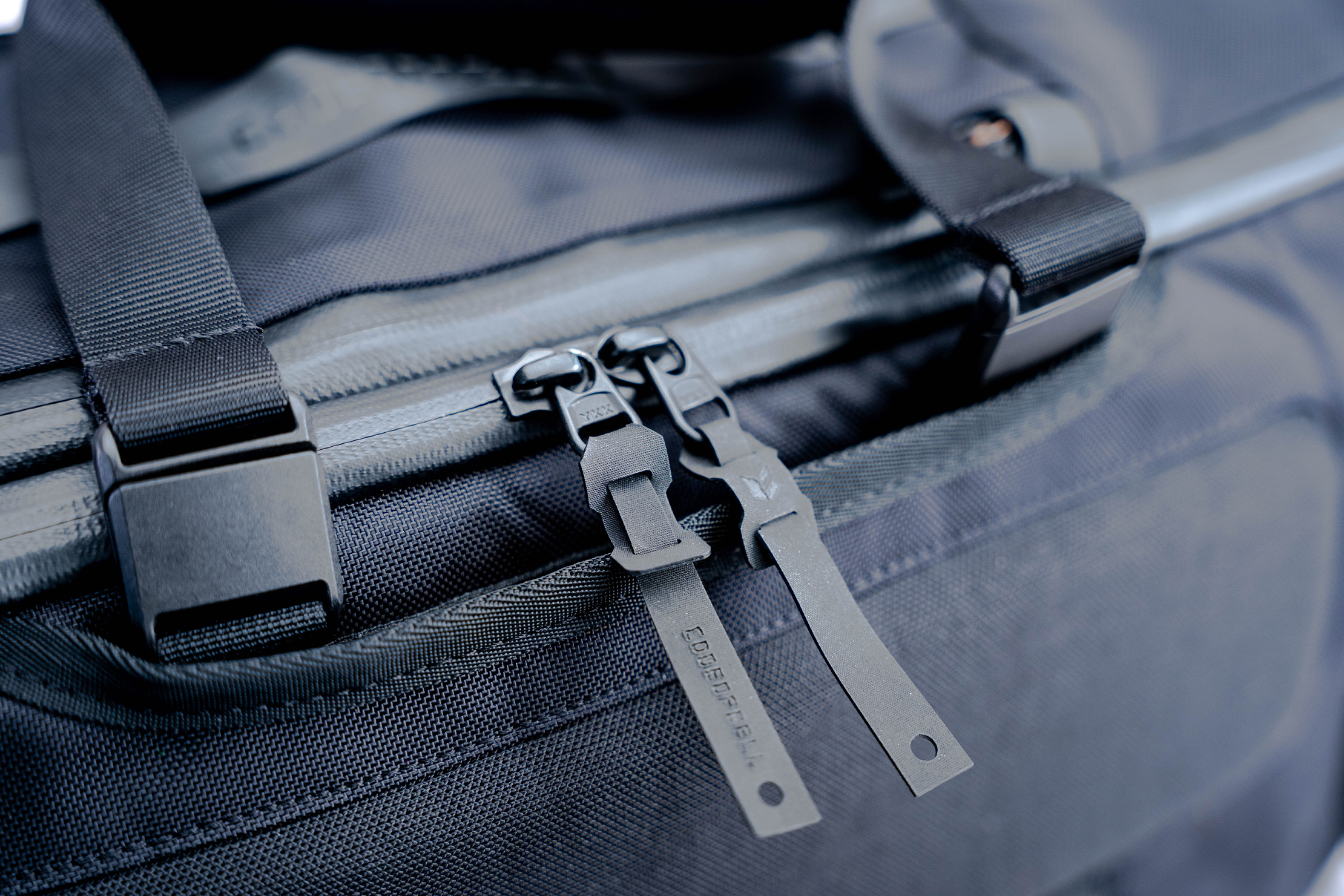
CODEOFBELL has thrown in a lot of quality materials from well-respected brands. Aside from the X-Pac fabric, there’s also Woojin hardware and YKK zippers, each with grippy Hypalon pulls, a nice touch that makes zipping and unzipping more satisfying. Many of the X-CASE’s zippered openings use YKK AquaGuard zippers. Unfortunately, we’ve heard a lot of complaints against this particular type of zipper, saying that they break down over time more easily compared to regular reverse coil zippers. We’ve yet to see any noteworthy damage or deterioration on the ones on the X-CASE, so we’ll give it a pass (at least for now).

There are even magnetic Fidlock buckles, which really drive home the point that the X-CASE is a 21st-century product. There is something to be said about their implementation on the X-CASE. As a quick-release buckle for the bag’s straps, they make sense. On the other hand, they seem unnecessary inside the main compartment, as you’ll see later on. Before we get inside the bag, though, let’s tour the outside and see all of the X-CASE’s exterior features.
External Components
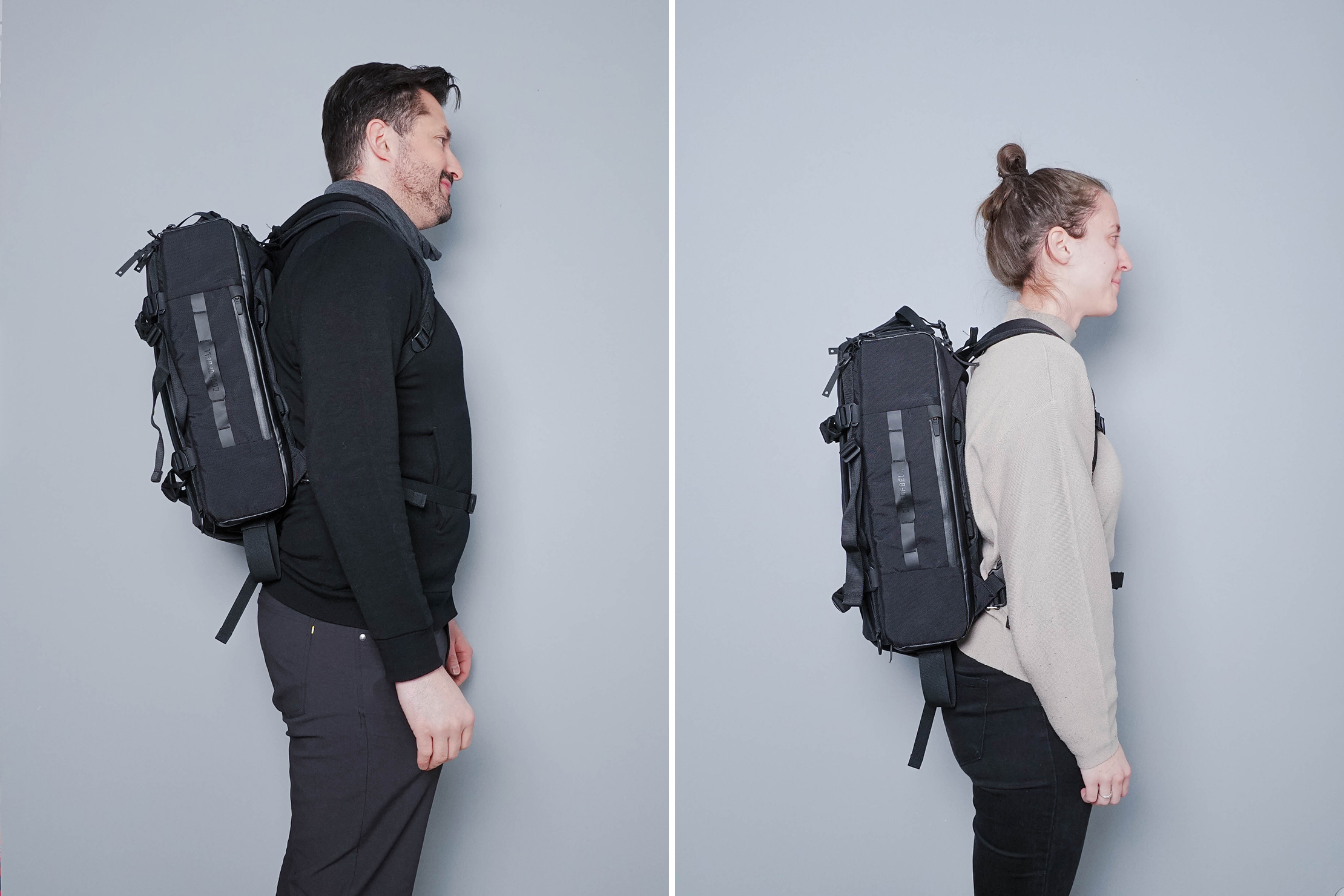
The X-CASE can be carried in three different ways: backpack, briefcase, and messenger-style. We’ll start off by checking out the handles for the briefcase mode since that seems to be the primary mode CODEOFBELL intends, as they describe the X-CASE as a 3-Way Brief Pack.
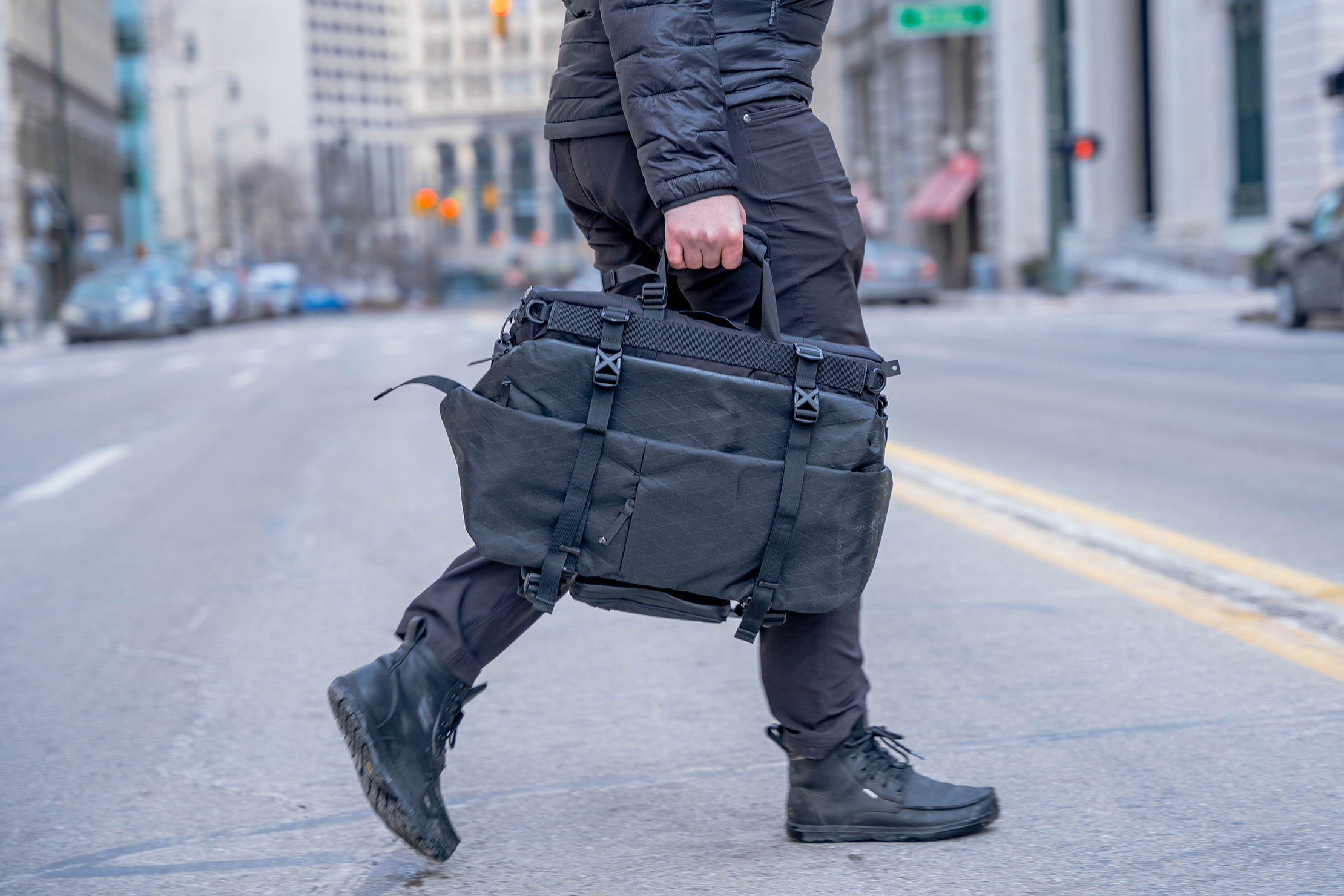
There are two handles along the top edge; one is permanently affixed, while the other is removable via magnets. Comfort-wise, these handles work well if you’re not carrying anything super heavy. There’s even a removable pad that can wrap around both handles. The pad itself secures via VELCRO and snap fasteners. It’s a bit tricky to lock the snap fasteners in place because the VELCRO is quite sticky. That said, locking both isn’t really necessary since the VELCRO is secure enough on its own.
It’s important to note that we avoid wrapping the pad around both handles because that gets in the way of the main compartment’s opening. It’s bothersome to have to do and undo the pad’s VELCRO each time, so we leave it attached to just one of the handles or stuff it in one of the X-CASE’s many pockets.
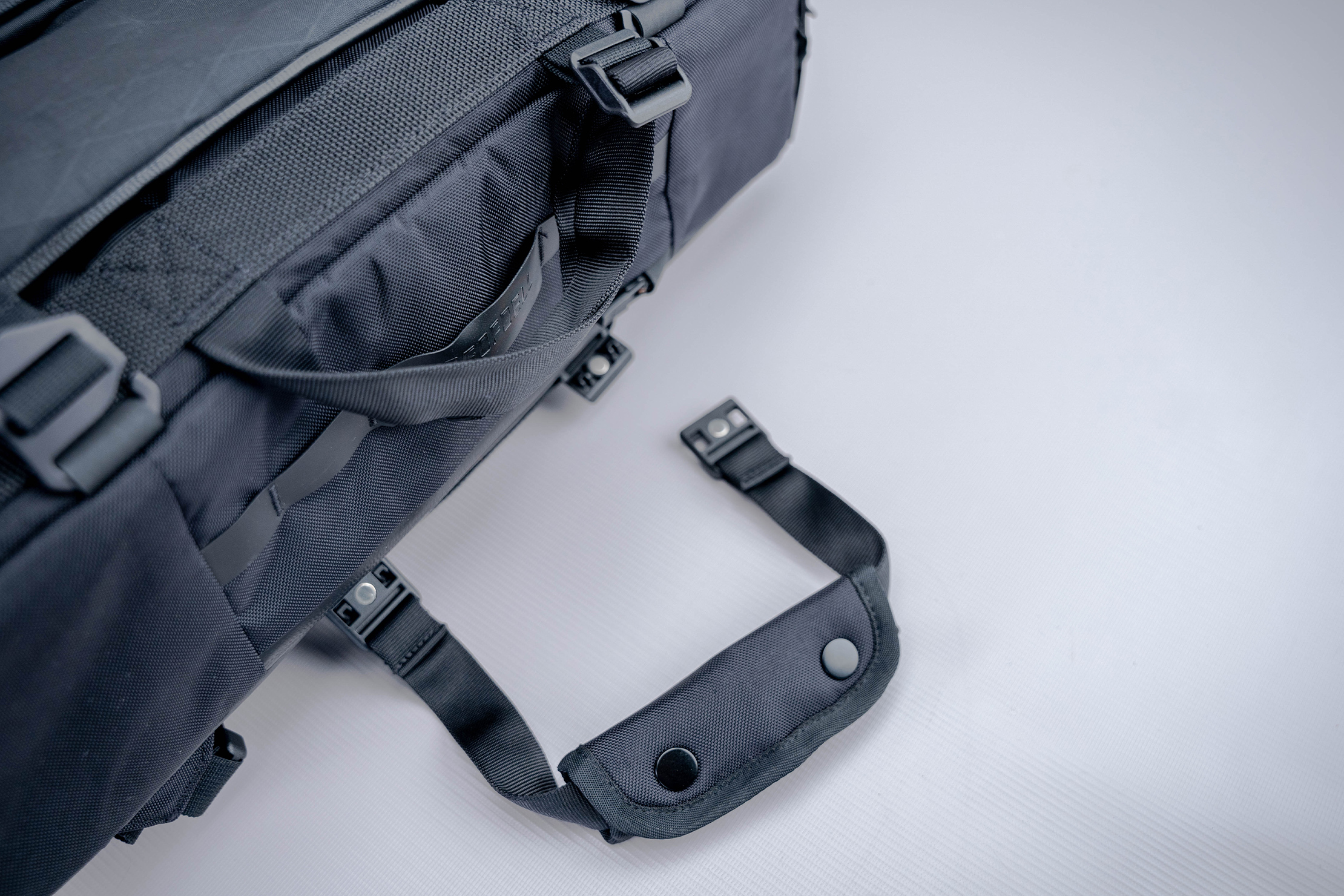
We found that each half of the handle has its own nitpicks when it comes to stowing them away. While the magnetically-attached half’s magnets make it convenient to remove and put away, it tends to fall off when jolted, which has happened quite a few times. Fortunately, it’s pretty secure once we’re actually using the handle when there’s sufficient tension for the magnetic clasps to stay together.
Meanwhile, the permanently attached half’s issue is less serious. Whereas the other half can be stowed away in a small VELCROed pocket, this one can only be tightened down. When tightened down, the handle’s extra slack is a bit dangly, and it can only be tamed by threading it through the Hypalon webbing. It’s not the cleanest look, but it’s better than having it flop around.
On the subject of those Hypalon webbings, the center loop is wide enough for us to use as a handle. It’s not quite wide enough to fit all four fingers, so it’s no replacement for the main handles. However, we use this center loop for quickly grabbing and moving the bag around short distances where it proves more convenient to use.
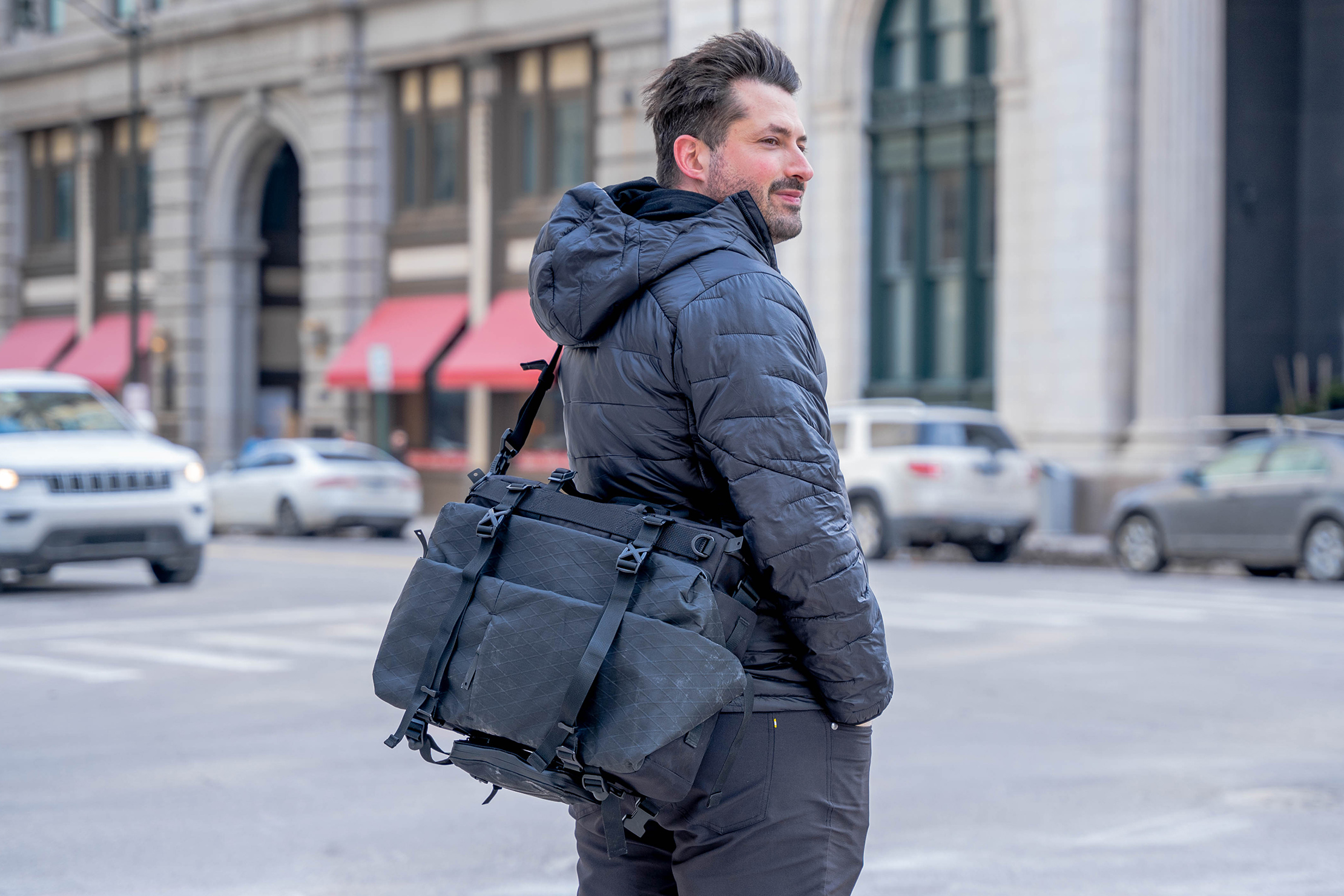
Given that the X-CASE is designed as a briefcase, it also carries well as a messenger bag. We’re not taking this for granted, though, as there’s much to appreciate about the included shoulder strap. It has a removable pad that is easy to shift along the length of the strap. We don’t find the need to do this often, though, since the pad is wide enough to easily cover the shoulder area anyway. For those who like to accessorize, the pad itself has a built-in D-ring and a set of three loops for attaching such items.
The shoulder strap’s padding is soft, comfortable, and able to cope with the bag’s 20-liter capacity. There’s even an elastic strap keeper to keep extra slack from dangling around and being a distraction. Your mileage may still vary, however, since the X-CASE’s expandable front compartment means load sticks out quite far. We’ll discuss more about our typical load once we get into the X-CASE’s interior features.
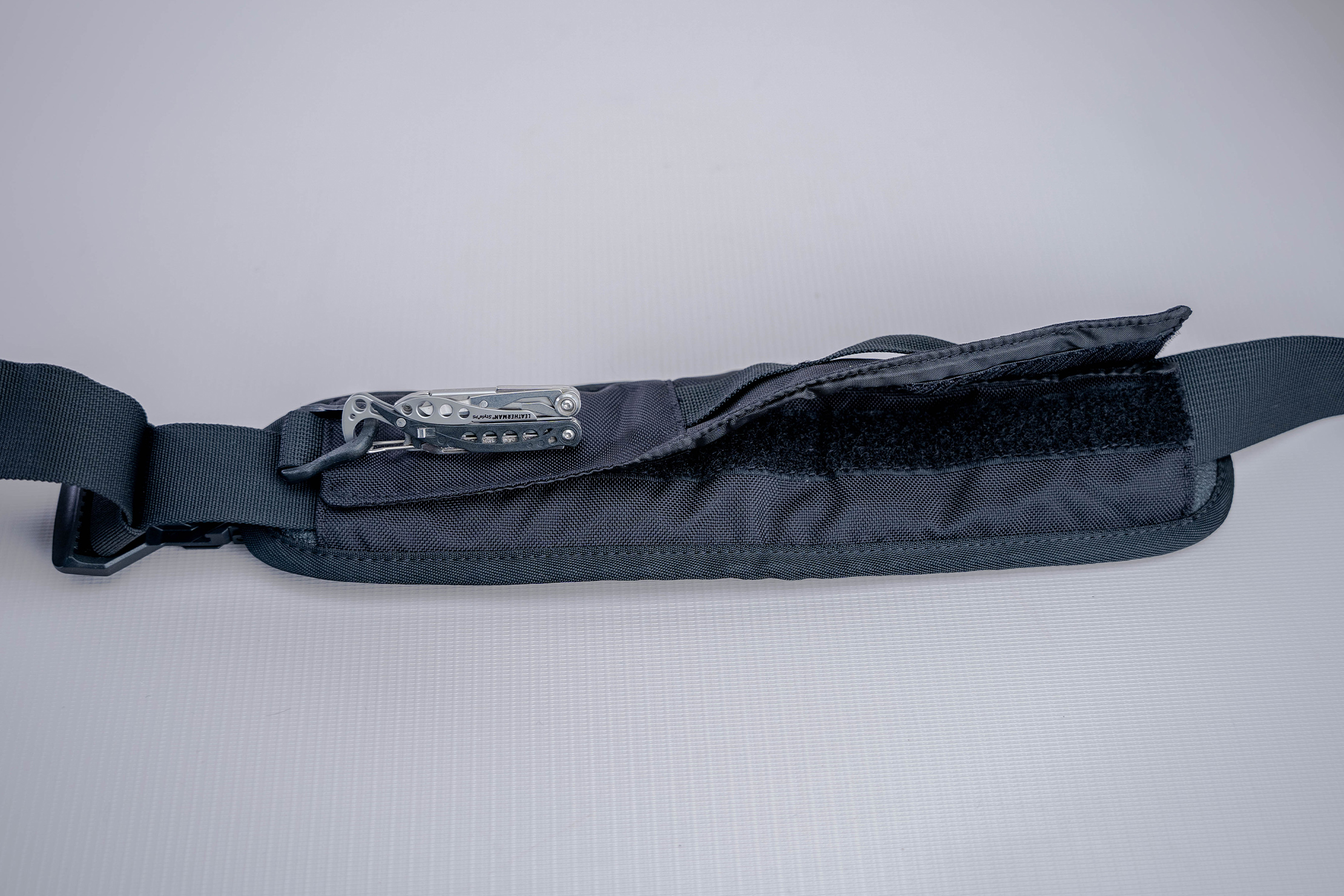
Like the briefcase handles, the X-CASE’s shoulder strap also stows away. One end of the strap is attached via a Fidlock buckle while the other is permanently attached. Those of you who have the ALPAKA Go Sling Mini might recognize the Fidlock buckle, as it’s the same. It’s easy and intuitive to undo by simply pulling on a short tab in the middle of the buckle. Of course, the main reason why there’s a magnetic buckle here in the first place is for detaching the bag quickly. In our testing, though, we don’t really find the need for this extra quickness.
It does make the stowing process easier, however. Once the Fidlock buckle is undone, it’s just a matter of folding the strap (including the pad) and stuffing it into the pocket just below where it’s permanently attached. At first, we were a bit unsure about the narrow-looking pocket. The good news is that it’s wide and spacious enough that inserting the folded strap is relatively hassle-free.
CODEOFBELL X-CASE | This strap stows away neatly into a side pocket.
Last but not least of the three modes is backpack mode. The backpack straps stow away in a compartment behind the back panel. The opening is secured by a single snap fastener, which CODEOFBELL thoughtfully mounted on a loop. This loop makes it easier to clasp the fastener by letting us push the male side simultaneously with the female side. Put another way, it’s as easy as pinching the two halves together. Once the straps are out, their ends are secured via buckles at the bottom edge of the back panel.
The backpack straps are well-padded, with their underside covered in breathable mesh material. They rest comfortably and feel very cushioned against our shoulders. Equally important is how these straps are mounted at the top. The strap isn’t entirely thick padding from bottom to top. Instead, the straps are permanently attached at the top end by a comparatively thin section of nylon. This lets the backpack straps flex and contour more freely with your posture and movement.
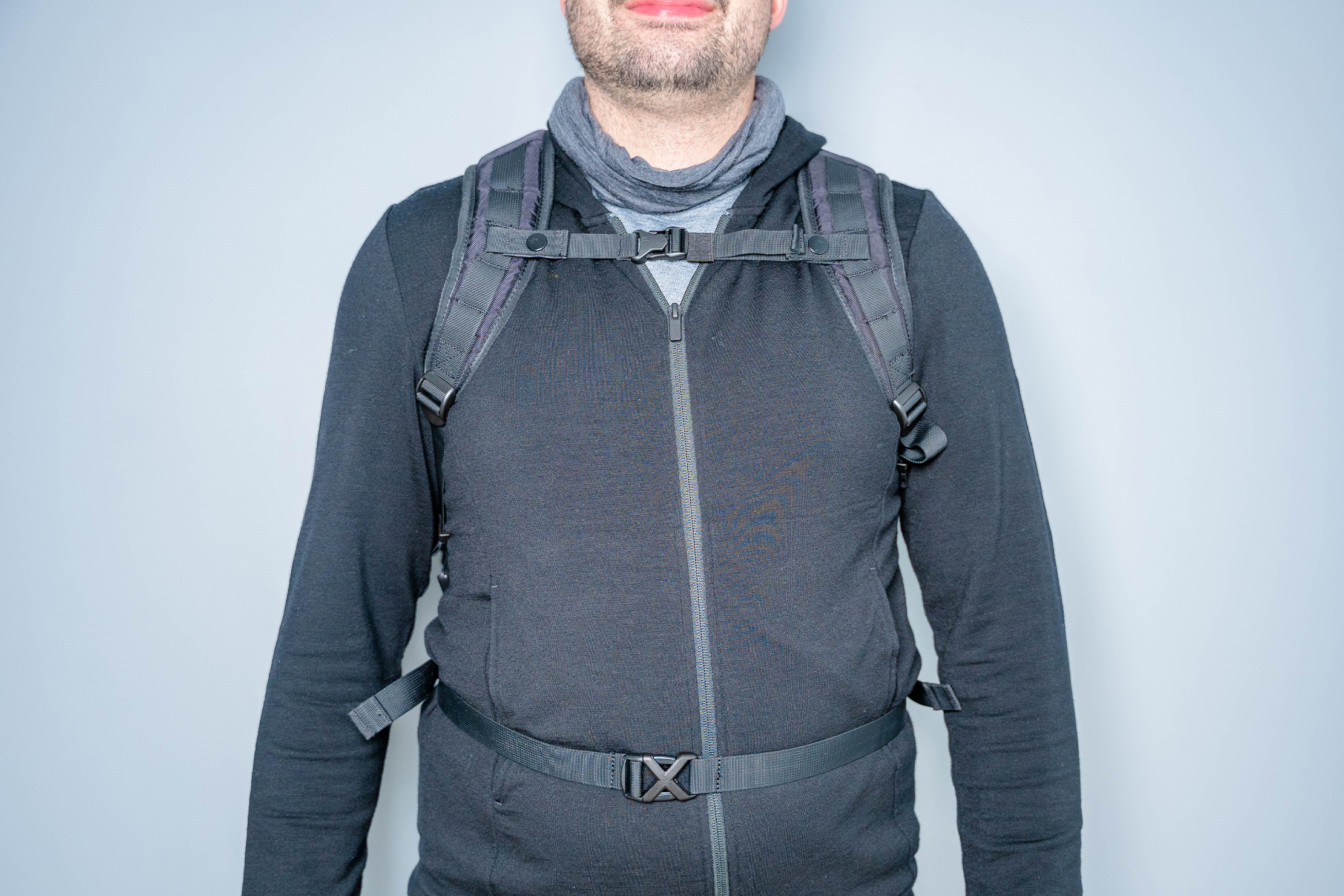
Additional straps include a sternum strap and a hip belt. The sternum strap is mounted via snap fasteners to a set of loops, five on each side. It’s not our preferred type of sternum strap (we like the kind that slides on rails), but it gets the job done. On the other hand, the hip belt attaches to nylon loops at the base of the back panel through gatekeeper clips.
Unfortunately, the gatekeeper clips tend to pop open on their own. In one incident, we took the X-CASE out of a car, and the strap fell to the curb. Thankfully, we were able to notice this before we lost the strap completely. In addition to the magnetic handle discussed earlier, this is another area where the hardware falls short of our expectations of reliability. Fortunately, the hip belt isn’t really a must-have on a bag of this size, so we recommend leaving it at home if you don’t have a use for it.
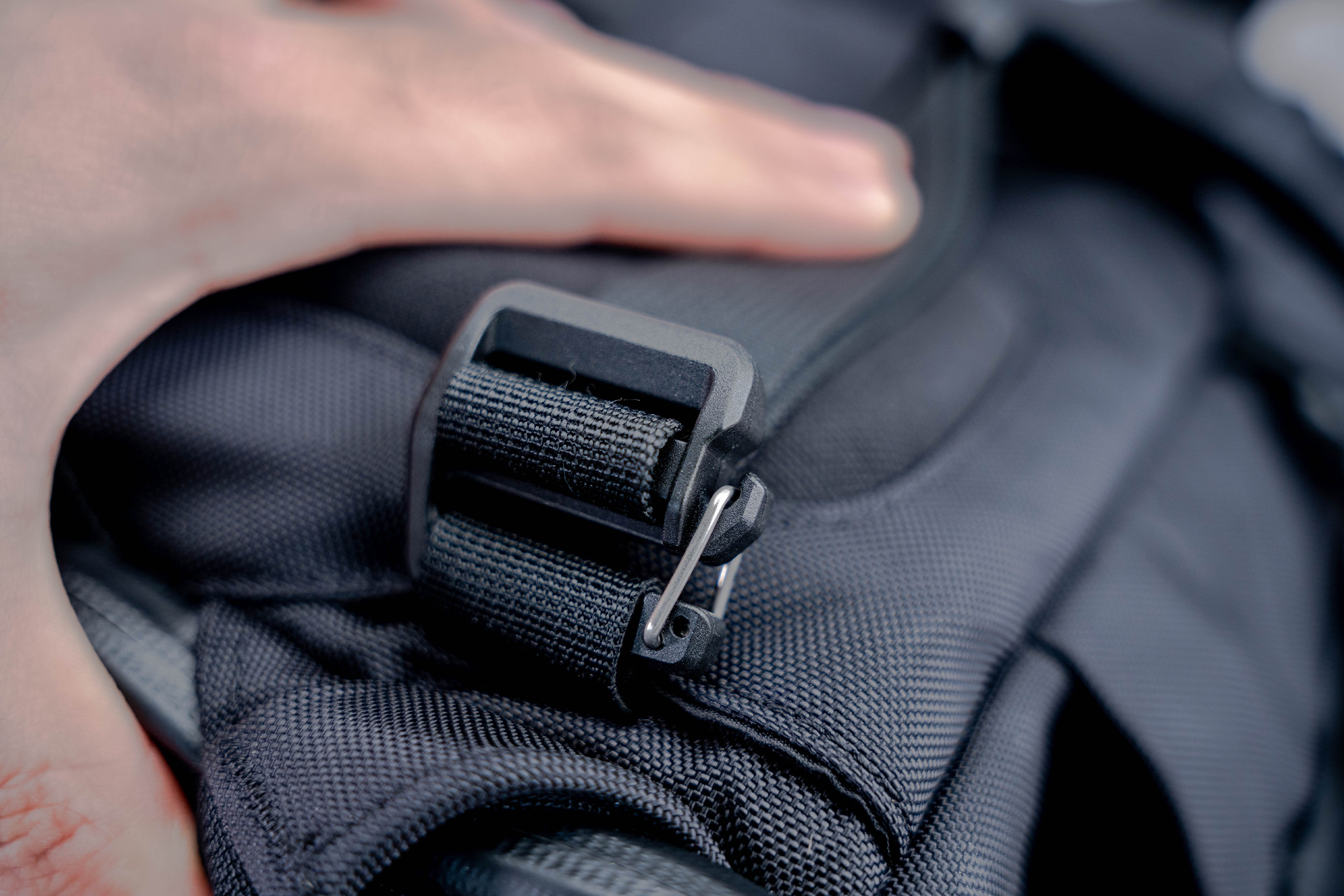
As with the shoulder straps, the X-CASE’s back panel is well-cushioned with two large sections of foam padding. Even with one of the briefcase handles stuffed behind it, there’s no noticeable bulge coming from it. A nylon strap in the middle of the two padded sections acts as a luggage passthrough. Because the X-CASE is a briefcase-style bag, the passthrough’s horizontal orientation is only appropriate.
The X-CASE carries fluently as a backpack as well. We don’t find its boxy profile stiff to carry since the padding on the straps and back panel cushions the load well. In fact, the stiffness stemming from the bag’s structuredness helps it sit flush on the wearer’s back, not to mention allowing the bag to stand on its own. Plus, the backpack straps’ flexible nylon joints at the top helps minimize fatigue around the shoulders by not hindering our arm movement and posture.
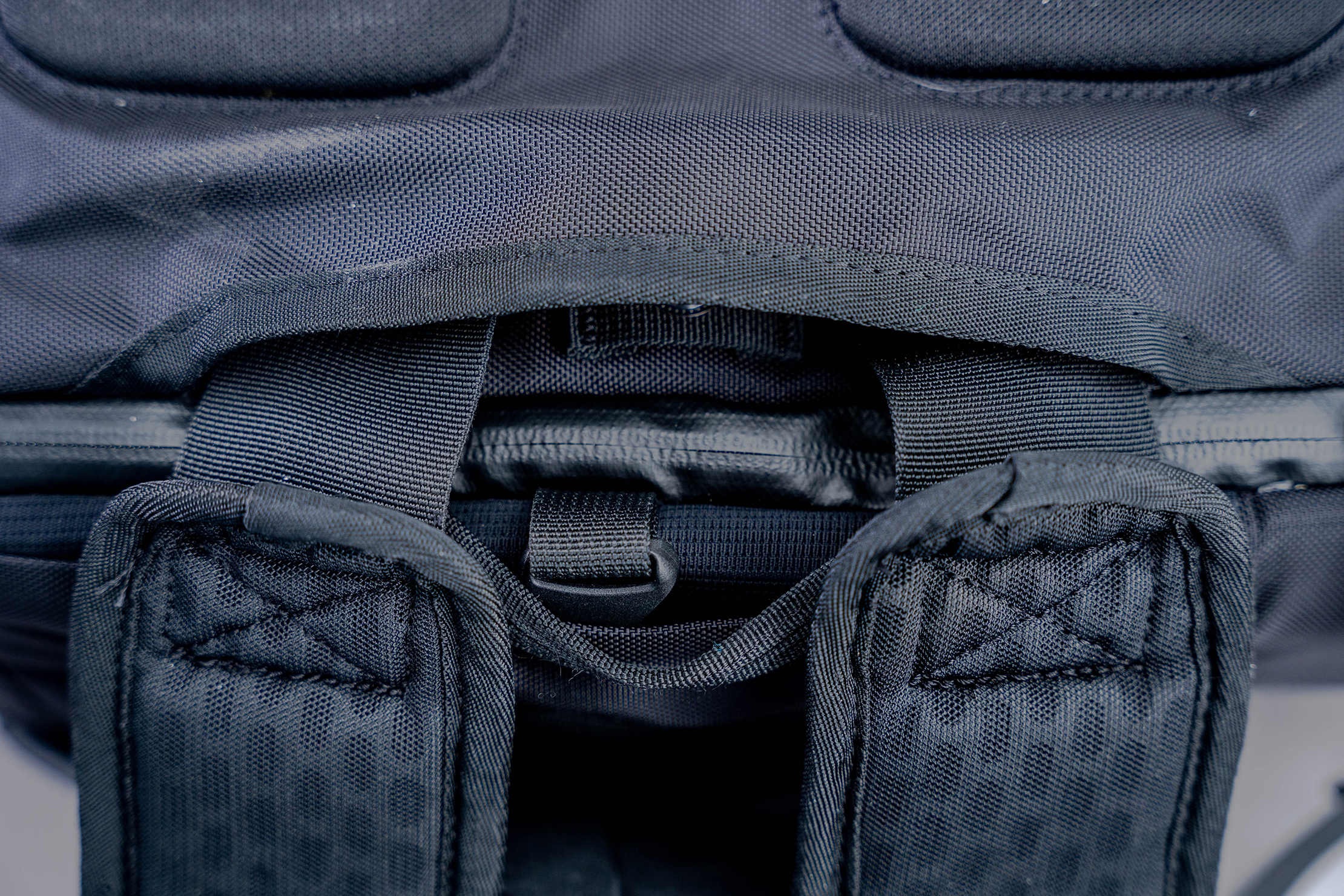
One of the major features of the X-CASE is its compatibility with CODEOFBELL’s ANNEX series gear. This includes the ANNEX LINER, ANNEX CASE, ANNEX CARRIER, and ANNEX ZIP. The ANNEX LINER attaches to the front compression straps via plastic clips, which come included with the X-CASE (eight pieces are provided). The ANNEX CASE and ANNEX CARRIER, on the other hand, attach to the Hypalon webbings found along the top, bottom, and sides of the bag. Just keep in mind which carrying mode you’re going to be using since you wouldn’t want to have something along a bottom edge where it can scrape off a surface.
As for the ANNEX ZIP, it’s small enough that it can attach to pretty much any of the loops, including the ones on the carrying straps. Overall, the system gives the X-CASE a degree of modularity, which is always good for those looking to upgrade down the line.
CODEOFBELL X-CASE | Did someone say “modular”?
As we just mentioned, there are two compression straps at the front of the X-CASE. They’re removable via the G-hooks, but they also have quick-release buckles if they need to be unfastened in a pinch. There’s also a pair of straps along the bottom, and this one’s for items like a yoga mat or a pair of sneakers, items that need to air out, and you don’t mind being at the bottom.
Inside The X-CASE
That was a lot of features on the outside alone, but now we’re ready to get into the orange-flavored filling that is the X-CASE’s interior. Yes, like their other gear, CODEOFBELL has lined the inside of the X-CASE with bright orange liner fabric. Before we get to the bigger compartments, though, let’s first take a look at the secondary pockets around the bag.
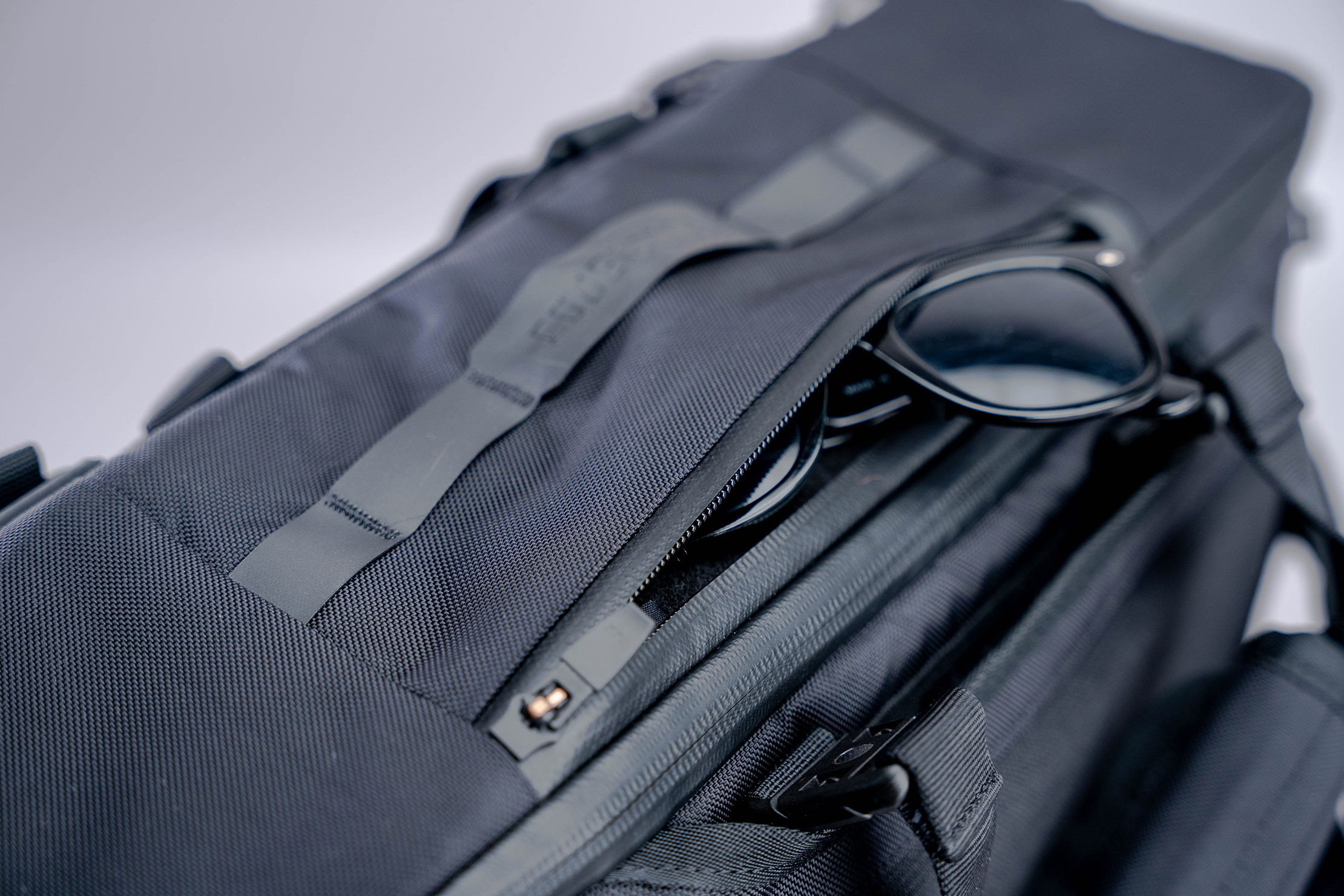
In briefcase or messenger bag mode, there’s a top pocket with a self-locking AquaGuard zipper, complete with a Hypalon garage for added protection. The inside of the pocket isn’t lined with orange fabric but instead a felt-like material. This material prevents scratches on fragile items like smartphones or sunglasses. Plus, the pocket is away from the tight areas, so there’s a minimized risk of those items getting crushed. The pocket is also RFID-protected, making it a good spot to put your wallet.
In backpack mode, that top pocket becomes a sideways one. Fret not, because there’s also a front quick-grab pocket you can use. We found this pocket a bit too narrow for our taste, though. Those with big hands among our crew have trouble reaching into the fairly deep pocket, some almost getting stuck. We don’t recommend placing really small items like coins or frequently-used dongles in here unless they’re in pouches that can be fished out more easily.
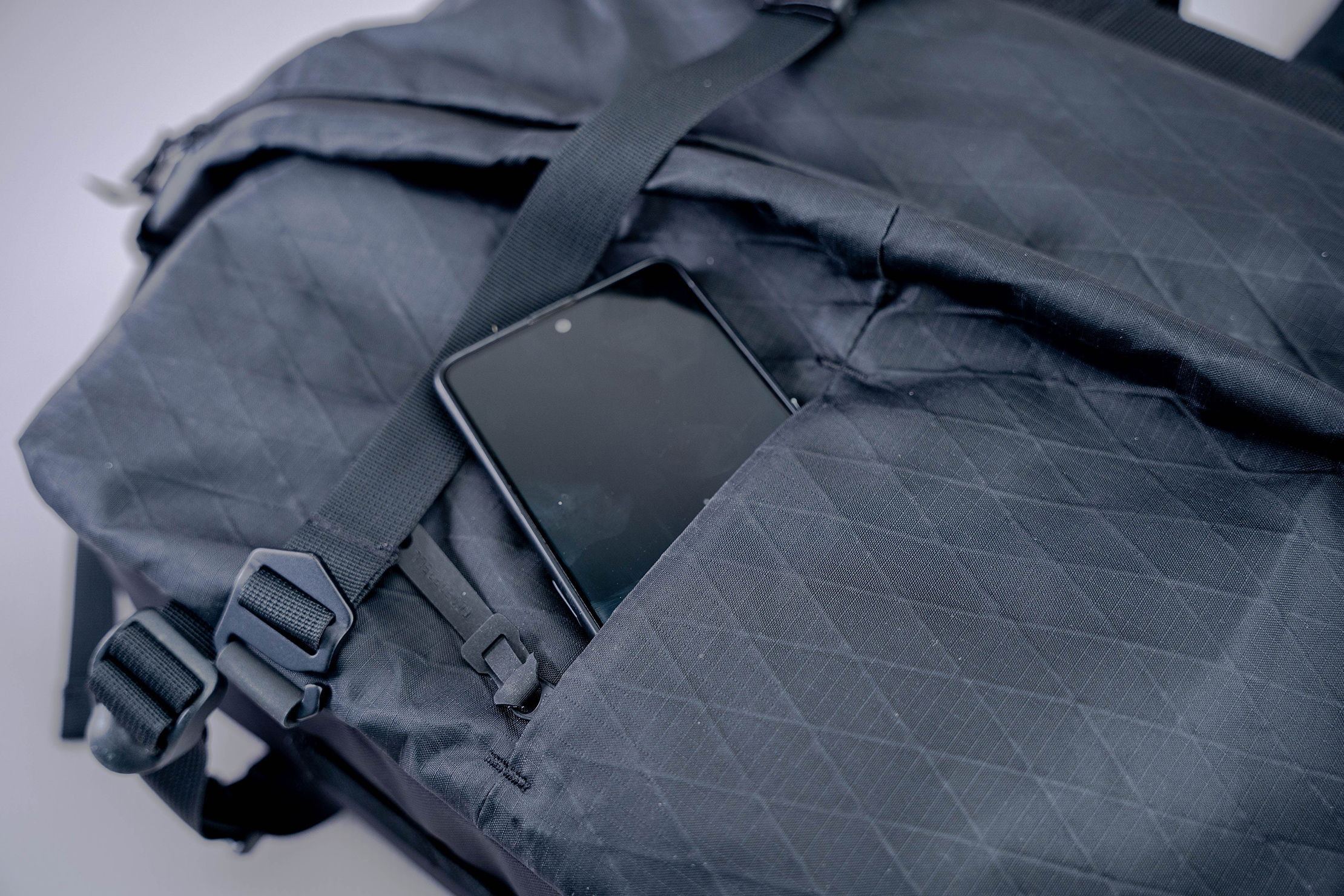
First up among the X-CASE’s major compartments is the front expandable compartment. There are two ways to access it: through a zippered opening along the top edge or through the front zippered opening. The latter isn’t actually visible while the compartment is in its compressed state and requires a bit of explaining, so let’s do just that.
A buckle on each side of the compartment compresses it down. This is in addition to the removable compression straps at the front, which must also be removed. Once all four buckles are undone, the front compartment can fully unravel and reveal the front zippered opening.
CODEOFBELL X-CASE | Need extra space? No problem.
When the compartment is uncompressed, there’s a ton of space available inside, enough to fit even a non-compressible jacket. It’s like a mini duffle bag built directly into the front of the X-CASE. We’ve seen this idea before in The North Face Bozer Hip Pack III. Of course, the X-CASE and the Bozer look nothing alike, but the concept of having a looser front compartment for bulky items is a shared trait between the two.
There are two zippered pockets inside, and both are gusseted for additional volume. Below those is a wide stretchy mesh pocket that’s big enough for winter gloves or rolls of socks. Within this pocket is a slit opening where you can see into the inner foam structure of the bag; not really something for everyday use, but it’s a neat sneak peek into the inner workings of the bag.
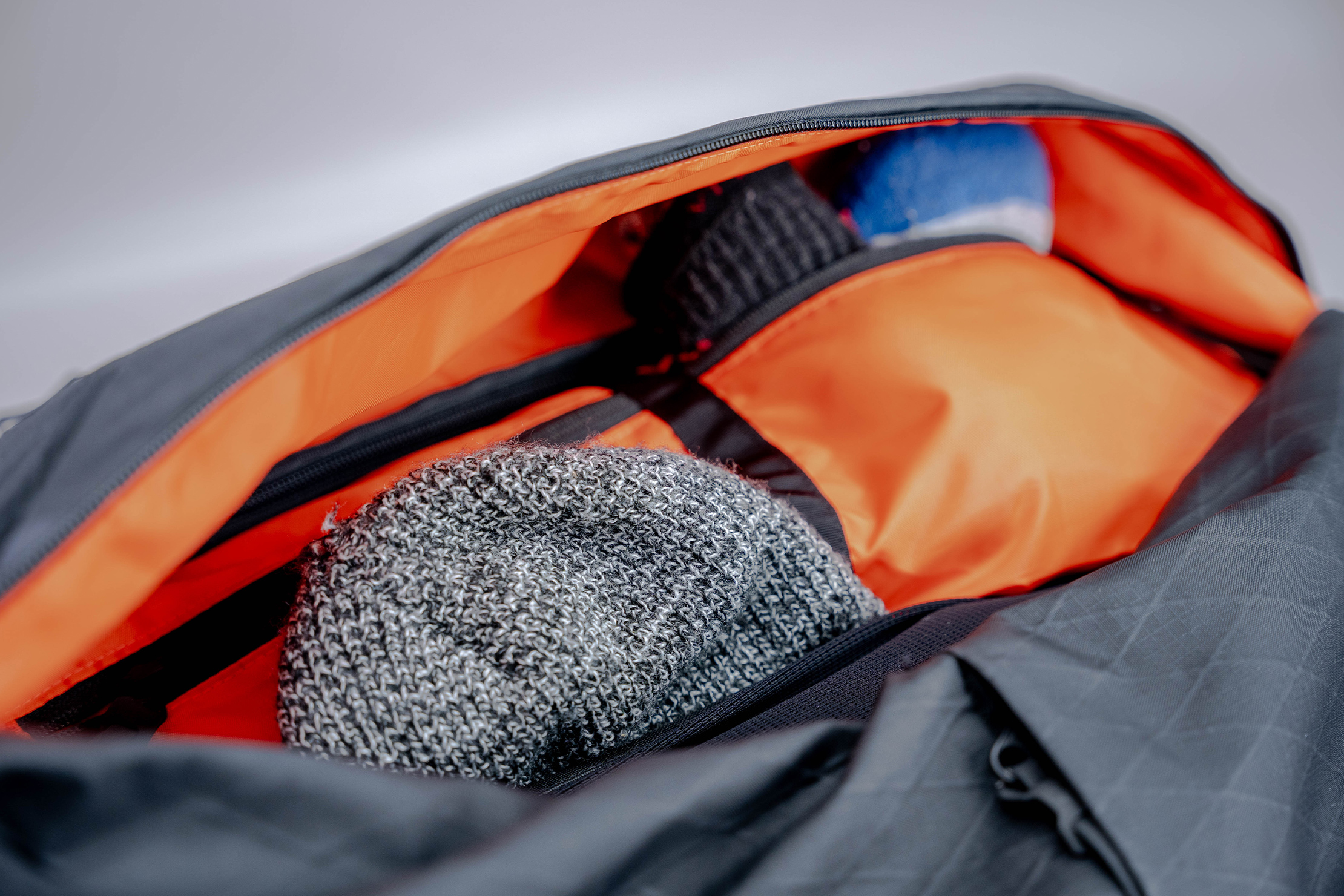
Lastly, there’s also a built-in key leash with a YKK clip. This is relatively easy to access from the compartment’s top opening. However, it might not be the most optimal place for keys if the compartment is packed tightly. In our case, we ultimately prefer to keep our keys in our own pockets since we have our own key organizer anyway.
Finally, we arrive at the main compartment, and here we have to tell you about our qualm with the X-CASE’s design: the opening. To be clear, the opening itself works fine; the zippers and Hypalon pull tabs make it a breeze to open and close. Its sideways flip-top opening works great in briefcase mode because of the horizontal orientation. However, as you can imagine, this doesn’t translate well in backpack mode where the bag sits vertically.
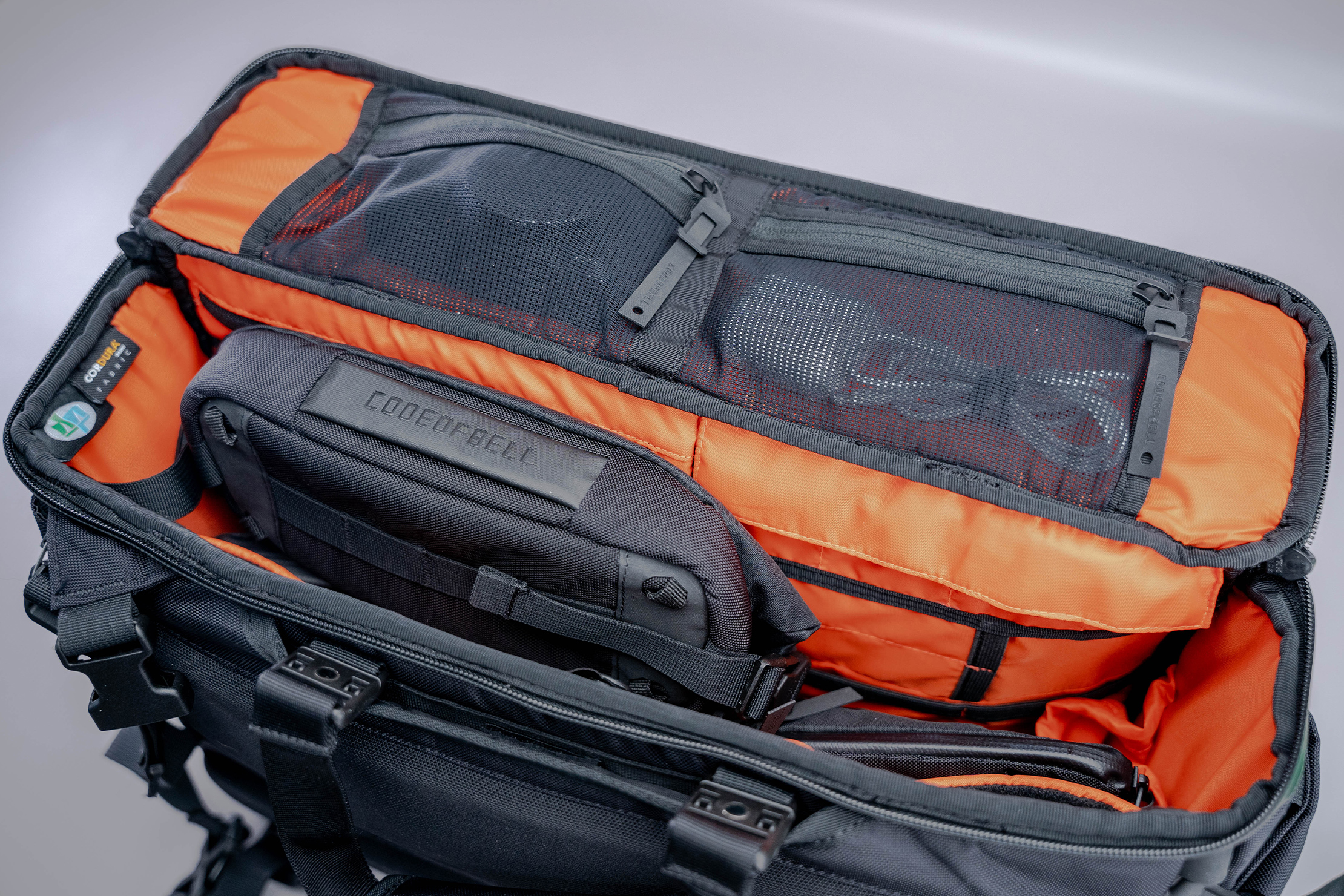
You have to orient the X-CASE horizontally each time you want to open it to prevent items from falling out. That said, it’s a minor inconvenience and not a total deal-breaker by any means. We just wish we could use the X-CASE as a full-time backpack without turning it into a brief once we need to open it.
Underneath the narrow lid is a pair of twin mesh pockets. They don’t appear that spacious, but the mesh material has a good amount of stretch. Even slightly bulky items like single-socket adapters can fit in here without bending the lid’s structure. Behind each of those is a sideways-opening slip pocket. Their openings aren’t sealed; thus, heavy items like power banks may slip out if you’re not careful.
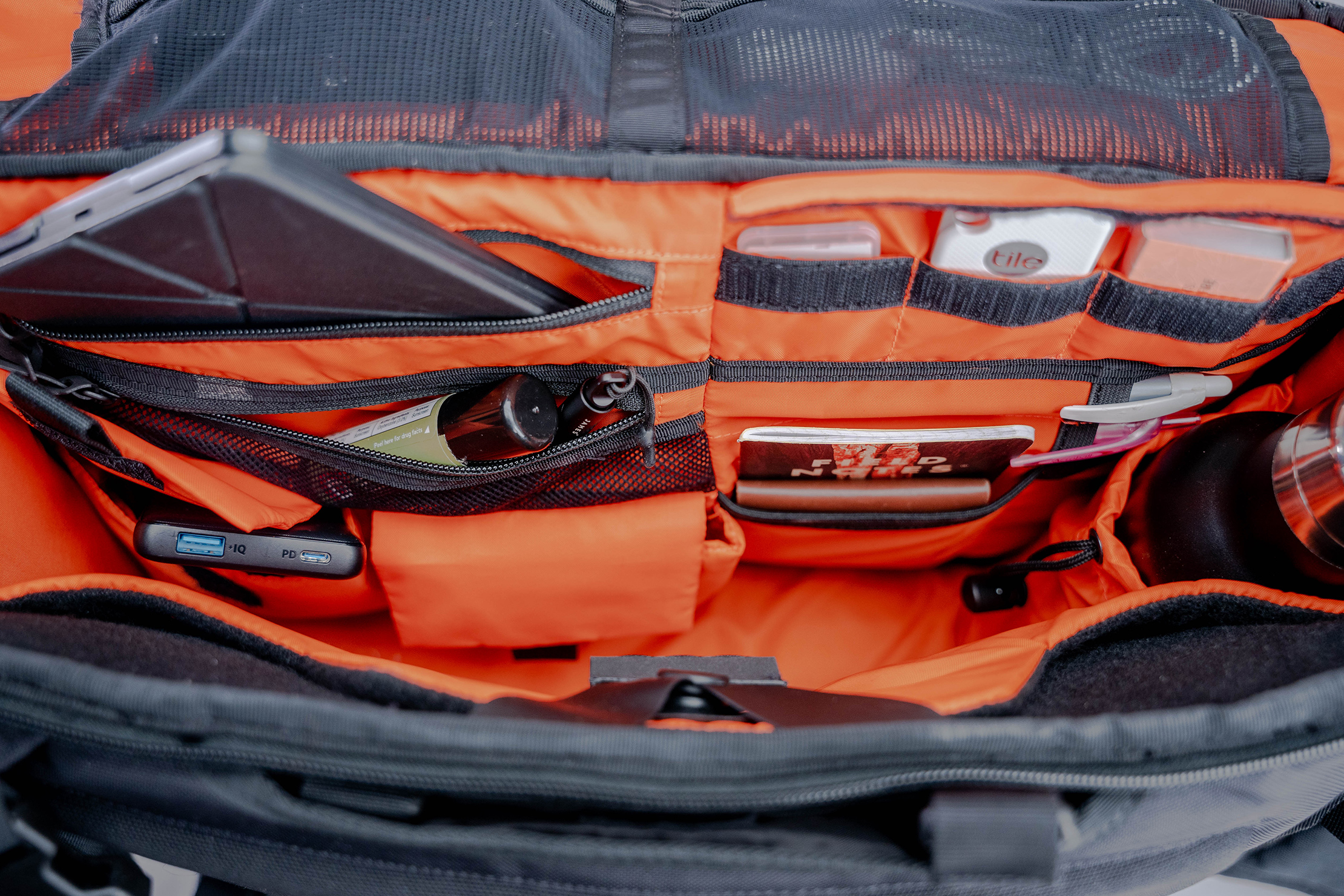
The front side of the main compartment is filled with pockets for further organization. The left side has two VELCROed pouches for accessories like a travel mouse and an external hard drive, respectively. Above those is a wide but shallow mesh pocket for small items, and this is where we place our omnipresent ChapStick. Lastly, the topmost section of this half is occupied by a zippered pocket big enough for our journal.
On the other hand, the right half is a bit more typical with its liner pockets. The passport and small notebook pockets are along the bottom, followed above by horizontal pen pockets. What’s not typical is the array of four small pockets meant to house small tech accessories like memory cards, USB-C adapters, or Apple AirTags. Note that these share a single flap, so opening one exposes the others.

CODEOFBELL didn’t forget to include a water bottle pocket, though it’s an internal one, which is slower to access than those on the outside. It’s a relatively slim one as we’re only able to fit our 18-ounce Hydro Flask inside. Still, it’s better than not having one at all and just having your bottle flounder around inside loosely.
Next up is the laptop sleeve. Like the expandable front compartment, there are two ways to access it. The first is through an independent zippered opening along the top of the back panel. Alternatively, it’s also accessible through the main compartment. Here the sleeve is locked down through a magnetic Fidlock buckle mounted on Hypalon. This is a bit too much considering there’s very little room to maneuver a buckle once the bag’s packed out.
CODEOFBELL X-CASE | Having a Fidlock buckle here is excessive.
That said, taking our 16-inch MacBook Pro through the back panel opening isn’t as easy as we hoped for either. There’s a separate document sleeve within the laptop sleeve, and its opening has a VELCROed section.—our laptop snags on this portion, requiring us to maneuver it carefully, paying extra attention not to hit the VELCRO.
There is still enough space inside for a few packing cubes and pouches despite the numerous pockets and large laptop sleeve. The only drawback here is that accessing those bottom-most pockets is quite cumbersome once the space is filled up. On the upside, the bright orange liner means navigating through a packed main compartment is much easier compared to if it were an all-black interior.
CODEOFBELL X-CASE | Access from this side isn’t too smooth either.
Phew! That was a lot to go through, but to be fair, the X-CASE has a very extensive features list. CODEOFBELL threw in everything from the smallest details like the Hypalon pull tabs and all the way up to the big stuff like the expandable front compartment. Is it overkill? In some areas, it is. A strap and handle came off on their own, some pockets are tricky to reach, and the main compartment opening that only optimally works horizontally.
Still, even with those rough edges, the X-CASE still has tons of functionality left to offer. So much so that we don’t consider sticking extra ANNEX-series gear on it necessary unless you’ve saturated its many, many pockets. It’s a feature-packed bag for those with a fully-packed needs.
Usage Timeline
Condition: Excellent
- Compatibility with the ANNEX series is a good way to expand capacity
- The durable X-Pac fabric just feels right and at home here
- Feels comfortable to carry in any of the three ways (backpack, brief, and messenger)
Condition: Excellent
- In typical CODEOFBELL fashion, all the material choices are top-notch with a price tag to match
- In testing, we had the briefcase handle and waist straps fall off unprompted—there’s a lot going on with this bag
- Although you can extend the X-CASE with the ANNEX CARRIER, LINER, and CASE, we feel there’s enough pocketing and organization already, and some configurations get in the way of features
- Comfortable to wear on backpack mode
- Structured shape allows bag to stand up on its own


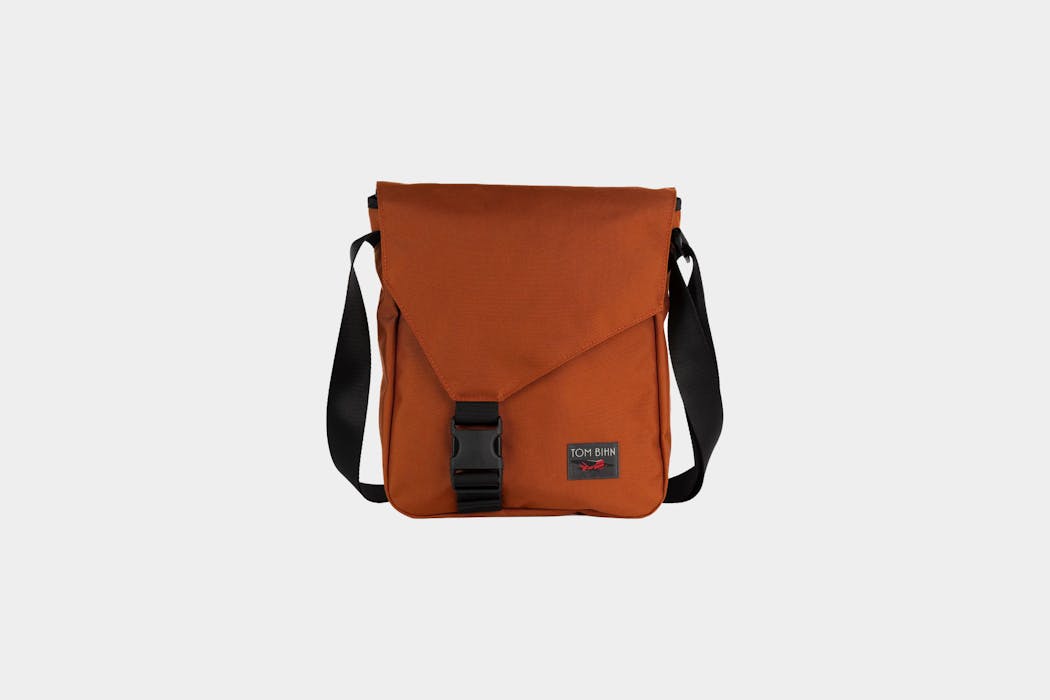




Get your questions about the CODEOFBELL X-CASE answered from our team and the Pro Community right here on the page. Plus, join discussions with other members about gear, guides, and more.
Join Pack Hacker Pro or, Sign In